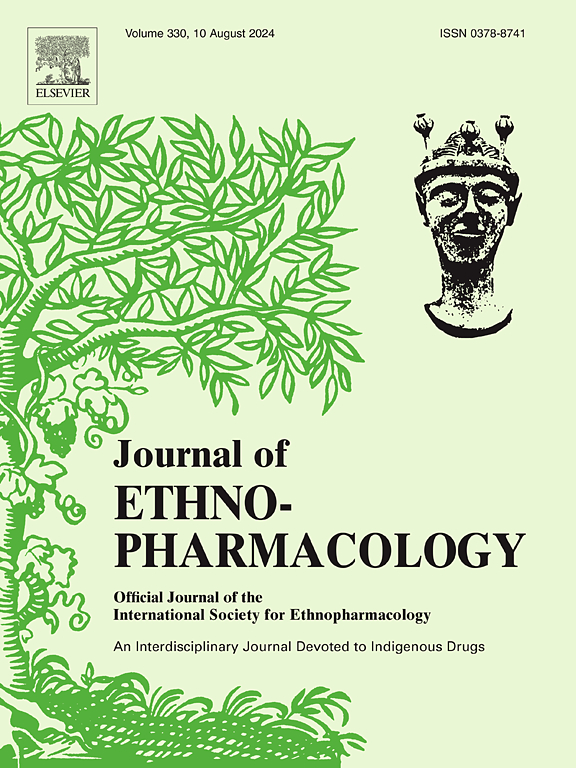Eucalyptus torquata: Chemical profiling and the therapeutic potential of its buds extract against Toxoplasma gondii infection in mice
IF 4.8
2区 医学
Q1 CHEMISTRY, MEDICINAL
引用次数: 0
Abstract
Ethnopharmacological relevance
Toxoplasma gondii is a protozoan parasite that infects many warm-blooded animals, including humans. The genus Eucalyptus has been used for centuries, particularly in traditional medicine, for its antimicrobial and anti-inflammatory properties.
Aim of the study
The phytochemical composition of Eucalyptus torquata buds extract was profiled and its potential to mitigate toxoplasmosis-related symptoms, counter histopathological insults, and inhibit cyst development in a mice model were investigated.
Materials and methods
HPLC-MS/MS was used to identify and annotate the phytochemical contents. Protective effects against acute and chronic toxoplasma infection were evaluated. Several biochemical parameters were tested, including AST and ALT, along with histopathological and immunohistochemistry assays. Molecular docking was utilized to pinpoint the compounds associated with the anti-toxoplasmosis activity.
Results
HPLC-MS/MS analysis revealed that the plant extract contained 61 secondary metabolites belonging to various polyphenols and organic acids. Administration of E. torquata extract at 200 and 400 mg/kg/day for 14 consecutive days to mice initially infected with T. gondii ME-49 strain significantly prolonged the survival time compared to the untreated and spiramycin-treated groups. In addition, the extract, especially at 400 mg/kg, reduced the brain cyst burden (53 % and 75 %) and viability (38 % and 43 %), and decreased animals’ mortality rates in both acute (48th-day post-infection) and chronic (64th-day post-infection) phases. Monitoring liver and renal function revealed that the extract counteracted the infection-induced damage. It significantly reduced AST, ALT, and creatinine levels and increased the serum albumin level compared to the untreated mice. Furthermore, the extract-treated mice groups showed a substantial reduction in neuron degeneration, hepatic necrosis, and the associated inflammatory signs. Immunohistochemical analyses of the cytoplasmic inducible nitric oxide synthase (iNOS) in brain and liver tissues showed that both the extract and spiramycin elicited significant decreases in iNOS expression in acute and chronic phases. Molecular docking suggested that epigallocatechin-epigallocatechin, gallic acid coumaroyl gallate, gallic acid shikimate, and galloyl diglucose had the most favorable binding affinities towards iNOS enzyme.
Conclusion
Altogether, these findings open a promising avenue into the potential role of E. torquata phytochemicals in managing toxoplasmosis and the related complications.

桉树:化学分析及其芽提取物对小鼠刚地弓形虫感染的治疗潜力。
民族药理学相关性:刚地弓形虫是一种原生动物寄生虫,可感染许多温血动物,包括人类。桉树属因其抗菌和抗炎特性已被使用了几个世纪,特别是在传统医学中。研究目的:研究了桉树芽提取物的植物化学成分,并在小鼠模型中研究了其减轻弓形虫病相关症状、对抗组织病理损伤和抑制囊肿发展的潜力。材料与方法:采用高效液相色谱-质谱联用技术对药材中的植物化学成分进行鉴定和注释。评估对急性和慢性弓形虫感染的保护作用。检测了几种生化参数,包括AST和ALT,以及组织病理学和免疫组织化学分析。利用分子对接技术确定与抗弓形虫病活性相关的化合物。结果:HPLC-PDA-MS/MS分析显示,该植物提取物含有61种次生代谢物,属于多种多酚类和有机酸类。最初感染弓形虫ME-49菌株的小鼠连续14天给予200和400 mg/kg/天的torquata提取物,与未治疗组和螺旋霉素治疗组相比,显著延长了存活时间。此外,特别是在400 mg/kg时,该提取物可降低脑囊肿负担(53%和75%)和生存能力(38%和43%),并降低动物急性(感染后48天)和慢性(感染后64天)期的死亡率。肝肾功能监测结果显示,该提取物可抵消感染引起的损伤。与未治疗的小鼠相比,它显著降低了AST、ALT和肌酐水平,并增加了血清白蛋白水平。此外,提取物处理的小鼠组显示出神经元变性,肝坏死和相关炎症症状的显著减少。免疫组化分析显示,大鼠脑组织和肝组织的胞质诱导型一氧化氮合酶(iNOS)在急性期和慢性期均显著降低。分子对接表明,表没食子儿茶素-表没食子儿茶素、没食子酸香豆酰没食子酸酯、没食子酸莽草酸酯和没食子二葡萄糖对iNOS酶的结合亲和力最强。结论:总之,这些发现开辟了一条有希望的途径,揭示了torquata植物化学物质在治疗弓形虫病及其相关并发症中的潜在作用。
本文章由计算机程序翻译,如有差异,请以英文原文为准。
求助全文
约1分钟内获得全文
求助全文
来源期刊

Journal of ethnopharmacology
医学-全科医学与补充医学
CiteScore
10.30
自引率
5.60%
发文量
967
审稿时长
77 days
期刊介绍:
The Journal of Ethnopharmacology is dedicated to the exchange of information and understandings about people''s use of plants, fungi, animals, microorganisms and minerals and their biological and pharmacological effects based on the principles established through international conventions. Early people confronted with illness and disease, discovered a wealth of useful therapeutic agents in the plant and animal kingdoms. The empirical knowledge of these medicinal substances and their toxic potential was passed on by oral tradition and sometimes recorded in herbals and other texts on materia medica. Many valuable drugs of today (e.g., atropine, ephedrine, tubocurarine, digoxin, reserpine) came into use through the study of indigenous remedies. Chemists continue to use plant-derived drugs (e.g., morphine, taxol, physostigmine, quinidine, emetine) as prototypes in their attempts to develop more effective and less toxic medicinals.
 求助内容:
求助内容: 应助结果提醒方式:
应助结果提醒方式:


